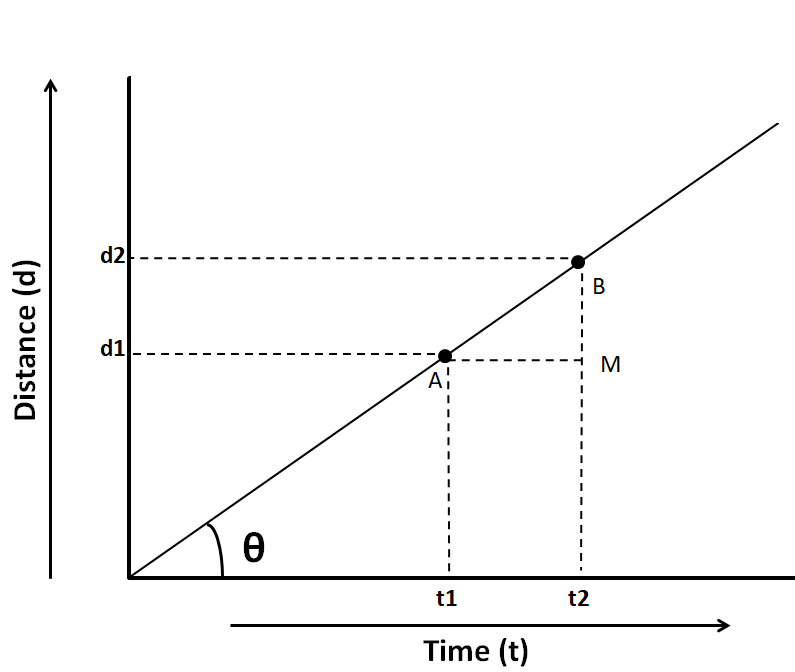
The data plotted on a graph of distance on the y-axis vs. time on the x-axis yields a linear graph. Identify which of the following options best describes the slope of the graph.
(A) $\dfrac{{\Delta d}}{{\Delta t}}$
(B) $(\Delta d)(\Delta t)$
(C) $\dfrac{{\Delta t}}{{\Delta d}}$
(D) $(\Delta d) + (\Delta t)$
(E) $(\Delta d) - (\Delta t)$
Answer
554.1k+ views
Hint
We need to draw a linear graph of distance on the y axis and time on the axis and take two points on it. Then we need to calculate the slope using its basic definition.
Formula Used: The formula used to solve this question is
$\tan \theta = \dfrac{{Height}}{{Base}}$
Complete step by step answer
As given in the question, the graph plotted between distance, $d$and time, $t$ is a linear graph. So we draw the graph according to the question.

Let the graph make an angle of $\theta $ with the x-axis. As the graph is linear, so its slope is constant at each point on the graph. For calculating the slope, we take two points, A and B on the graph and calculate the slope from their corresponding coordinates. According to the definition, slope of a line is equal to the tangent of the angle made by that line with the x-axis, i.e.
Slope, $m = \tan \theta $
As $\tan \theta = \dfrac{{Height}}{{Base}}$
$\therefore m = \dfrac{{Height}}{{Base}} = \dfrac{{BM}}{{AM}}$
From the triangle AMB in the figure above,
$BM = d_2 - d_1$, ${\text{AM = t}}2 - t_1$
Substituting these in the above equation, we get
$m = \dfrac{{d_2 - d_1}}{{t_2 - t_1}}$
$\therefore m = \dfrac{{\Delta d}}{{\Delta t}}$
So, we have a slope equal to$\dfrac{{\Delta d}}{{\Delta t}}$.
Hence, the correct answer is option A, $\dfrac{{\Delta d}}{{\Delta t}}$/
Note
The graph in this question is plotted between distance and time. We know that the slope of such a graph indicates the velocity. So the unit of slope will be the same as the unit of velocity, i.e. $m/s$. From the options given, only A ($\dfrac{{\Delta d}}{{\Delta t}}$) has the unit of velocity. Thus, these types of questions can also be attempted through the knowledge of units and dimensions.
We need to draw a linear graph of distance on the y axis and time on the axis and take two points on it. Then we need to calculate the slope using its basic definition.
Formula Used: The formula used to solve this question is
$\tan \theta = \dfrac{{Height}}{{Base}}$
Complete step by step answer
As given in the question, the graph plotted between distance, $d$and time, $t$ is a linear graph. So we draw the graph according to the question.

Let the graph make an angle of $\theta $ with the x-axis. As the graph is linear, so its slope is constant at each point on the graph. For calculating the slope, we take two points, A and B on the graph and calculate the slope from their corresponding coordinates. According to the definition, slope of a line is equal to the tangent of the angle made by that line with the x-axis, i.e.
Slope, $m = \tan \theta $
As $\tan \theta = \dfrac{{Height}}{{Base}}$
$\therefore m = \dfrac{{Height}}{{Base}} = \dfrac{{BM}}{{AM}}$
From the triangle AMB in the figure above,
$BM = d_2 - d_1$, ${\text{AM = t}}2 - t_1$
Substituting these in the above equation, we get
$m = \dfrac{{d_2 - d_1}}{{t_2 - t_1}}$
$\therefore m = \dfrac{{\Delta d}}{{\Delta t}}$
So, we have a slope equal to$\dfrac{{\Delta d}}{{\Delta t}}$.
Hence, the correct answer is option A, $\dfrac{{\Delta d}}{{\Delta t}}$/
Note
The graph in this question is plotted between distance and time. We know that the slope of such a graph indicates the velocity. So the unit of slope will be the same as the unit of velocity, i.e. $m/s$. From the options given, only A ($\dfrac{{\Delta d}}{{\Delta t}}$) has the unit of velocity. Thus, these types of questions can also be attempted through the knowledge of units and dimensions.
Recently Updated Pages
Master Class 12 Economics: Engaging Questions & Answers for Success

Master Class 12 Maths: Engaging Questions & Answers for Success

Master Class 12 Biology: Engaging Questions & Answers for Success

Master Class 12 Physics: Engaging Questions & Answers for Success

Master Class 8 Maths: Engaging Questions & Answers for Success

Class 8 Question and Answer - Your Ultimate Solutions Guide

Trending doubts
Which animal has three hearts class 11 biology CBSE

1 Quintal is equal to a 110 kg b 10 kg c 100kg d 1000 class 11 physics CBSE

Explain zero factorial class 11 maths CBSE

Mention the basic forces in nature class 11 physics CBSE

What is centripetal acceleration Derive the expression class 11 physics CBSE

Bond order ofO2 O2+ O2 and O22 is in order A O2 langle class 11 chemistry CBSE




